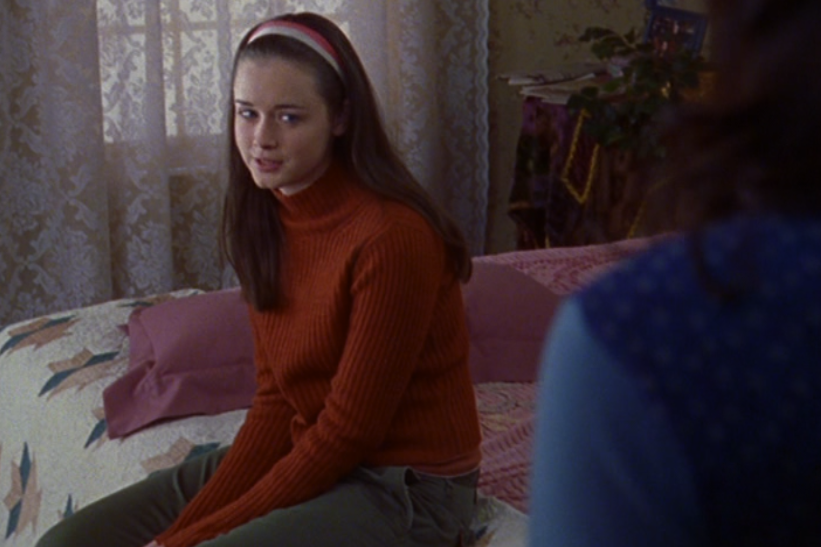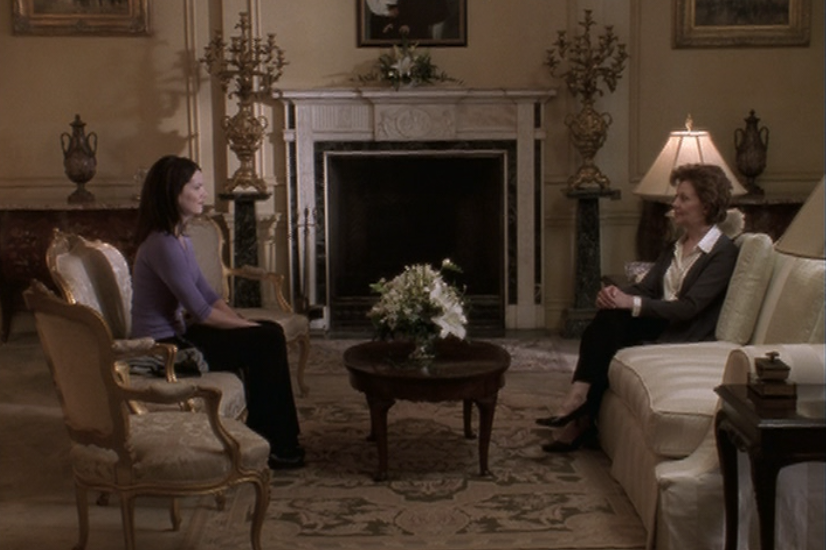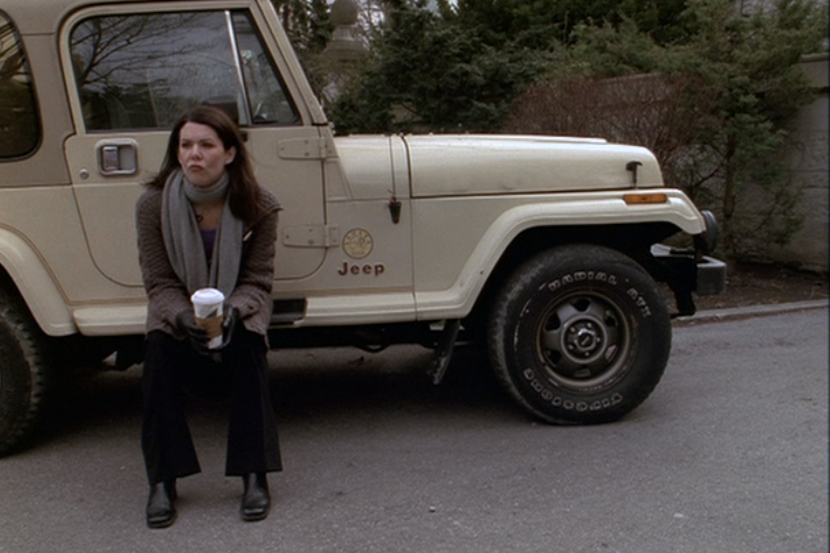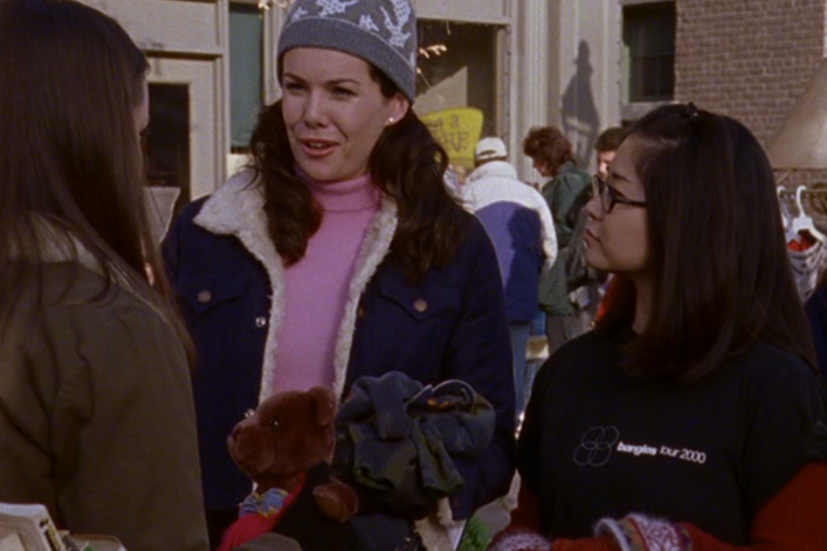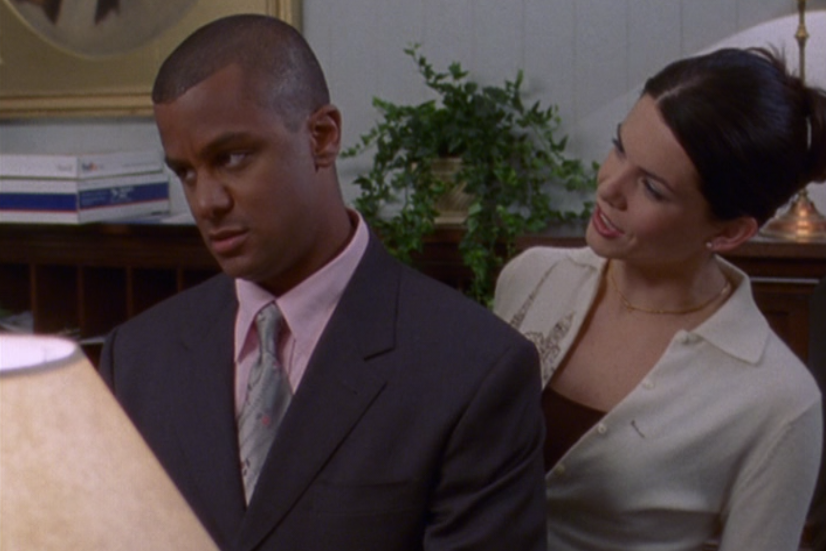“That’s Where the Colors Don’t Go”
Costume Design on Season One of Gilmore Girls
Originally published on Letterdrop 7/14/2022
From the first episode, Gilmore Girls is a show about mothers and daughters—how alike and unalike they can be, how easily and how arduously they relate to each other—and through no lens are these relationships clearer than the show’s costume design. In season one, each Gilmore girl gets dressed with a different purpose in mind.
For teenage Rory, fashion is utility and practicality. To quote costume designer (then supervisor) Brenda Maben, Rory doesn’t “really care about her clothing” (Observer) in the early years of the show. She cares more about books, academics; while the girls in her class pass around a bottle of nail polish, she does the assignment (1.1). Her season one wardrobe is populated with loose-fitting khakis, jeans, sweaters, turtlenecks, and minimal jewelry; her shoes Docs or sneakers. (Her mother, Lorelai, labels the above sweater a “muumuu” (1.1).) For better and often worse, Rory is the “sensible one” (1.1) in her household, and her clothes say as much.
Rory in 1.13
(I should note that Alloy.com provided some of season one’s clothes—so if you were a teen viewer who liked Rory’s outfits, you could shop them from home.)
Note the diamond studs and the rhinestones on the bandanna (1.13). Lady loves some sparkle!
Lorelai at work in 1.18
For Lorelai, fashion is fun and creativity. When working at the Independence Inn, she favors suits and printed blouses, but at home, she’s in jeans and funky graphic T-shirts, so youthful and trendy that she and Rory are often perceived as friends, not mother and daughter. She even sews and knits, a necessity of life “post–Gilmore economy” (4.7). The only reminder of her parents’ wealth is Lorelai’s diamond studs, which Maben imagined were “leftovers” (The Hollywood Reporter) from her teenage years. Her most conservative outfits are saved for Friday Night Dinners at the Gilmore mansion, a “throwback to how [she] was brought up” (Observer).
Emily in 1.5
After all, for Lorelai’s mother, Emily, fashion is appearance and decorum. Of the three Gilmore girls, her style remains the most static, her go-to pieces tweed Chanel-like suit jackets, black pencil skirts or trousers, silk blouses, pearls; her baggage Louis Vuitton. There’s no room for deviation, for trends or ostentation, in the Gilmores’ WASP-y world, and so Emily remains loyal to what she knows is acceptable and tasteful.
Richard in 1.8
Emily’s style even extends to her husband, Richard, an insurance executive. Maben had all of Richard’s suits—always paired with his signature bow ties—custom-made and embroidered with his initials. “His character [could] probably care less about the embroidery,” thought Maben, “but Emily probably said, ‘No, Richard, you should have this done’” (Vanity Fair).
Emily and Lorelai in 1.1
Each Gilmore looks at home in their own world: Emily’s and Richard’s wardrobes are muted and controlled, just like their stately Hartford mansion—fine furniture and drapes all in shades of cream and brown, touches of gold to tie back to Emily’s signature jewelry, a gold chain and small gold hoops. Rory’s and Lorelai’s clothes are colorful and dynamic, just like their small, quirky Stars Hollow; their cluttered, homey house: Rory chooses olive green, red, and orange; Lorelai, purple, pink, and her favorite color, blue.
Even the camera moves differently in these respective worlds: According to the director of the pilot, Lesli Linka Glatter, Stars Hollow is intentionally shot to feel “very fluid . . . [with] a lot of energy around it,” while the Gilmore mansion is “much more presentational . . . a world that energy [isn’t] flowing in” (“Welcome to the Gilmore Girls”).
Lorelai sits outside the Gilmore mansion in 1.1.
Lorelai inside the Gilmore mansion in 1.1
But let’s go back to the pilot, the point at which these two worlds intersect. Lorelai reluctantly goes to the Gilmore mansion to ask for money for Rory’s new private school; as her parents remark, she normally only visits for Christmas or Easter. Lorelai felt stifled in her childhood home, so much so that she left as a teen, her baby daughter in tow.
Lorelai keeps her outfit neutral, palatable: a long brown cardigan, gray scarf, and black pants; her usual diamond studs and little silver cross (while Emily favors gold—more expensive—Lorelai likes silver). Only once Lorelai removes her cardigan, revealing the purple sweater underneath, does she become the focal point, the one bright spot in her parents’ living room.
Richard in 1.1
Emily in 1.1
Richard wears one of his usual black suits; his light blue button-down and blue-green bow tie are touches of Lorelai’s signature color. He understands, before Emily does, that Lorelai “needs money” and offers it without condition. But Emily wants something in exchange, a weekly dinner at the Gilmore mansion. Clearly, this house is Emily’s domain, much more than Richard’s: the place where she hosts parties and DAR meetings and directs an endless turnover of maids. She fits perfectly into her living room: a gray cardigan, cream blouse, and black slacks; her jewelry gold hoops and a gold pendant necklace.
A photograph on Lorelai’s mantelpiece (1.1)
The portrait hanging in the Gilmore mansion living room (1.1)
The scene is bookended by family portraits—a photograph of young Lorelai, all in black, standing in front of the Gilmore mansion, and a painting of the Gilmore parents and young Lorelai, all three in white and black. Sam Phillips’s song “Where the Colors Don’t Go” plays in the background. Only skywriting would be more obvious: The bright colors and vitality found in Stars Hollow have no place in the Gilmore mansion.
Rory sits in the headmaster’s office in 1.2.
Then there’s Rory’s new private school, Chilton, a place where everyone wears blue and clothes seemingly don’t matter. Rory is thrilled to wear a uniform: “No more having people check you out to see what jeans you’re wearing ’cause everyone’s dressed alike in the same boring clothes” (1.1). But as Rory and Lorelai soon find, clothes are incredibly important at Chilton—for students and parents.
Indeed, female Chilton students aren’t dressed exactly alike. Yes, there’s a limited selection of tops (a blue blazer, navy or gray cardigan or sweater-vest, white or blue button-down) and only one bottom (a blue plaid kilt), but everyone mixes them differently, accessorizes as they see fit with matching knee socks, tights, and headbands. They even hem their skirts to different lengths: Rory tells her mother not “too short” (1.1).
Paris and Rory meet in 1.2.
On her first day (1.2), Rory pairs her kilt with a blue button-down, blue blazer, and navy crossover tie. In the hallway, she meets her soon-to-be rival and eventual friend, the prickly and ambitious Paris Geller. Paris is wearing the same uniform pieces as Rory: She sees Rory as her potential replacement, her competition for valedictorian and editorship of the school paper.
Madeline (left) and Louise (middle) in 1.2
Paris’s sidekicks, Madeline Lynn and Louise Grant, aren’t wearing blazers. No, they’re sweater girls: Madeline in a blue button-down and gray cardigan; Louise in a white button-down and navy cardigan. They are softer, nonthreatening, even interchangeable, blond and brunette versions of each other. Paris can be friends with them because she is not intimidated by them academically.
Lorelai mends Rory’s cardigan in 1.14.
As the season continues and Rory and Paris grow closer, Paris keeps her blazer—her armor—but Rory starts wearing a navy cardigan or sweater-vest more. The real turning point comes in episode thirteen: After Rory and Paris bond at a Bangles concert, Rory stops wearing a blazer altogether. Though she and Paris still have their ups and downs, the door for their friendship is permanently open.
I imagine, too, that these new pieces were gifted by Emily—or, maybe more likely, bought out of spite by Lorelai. After Rory’s first day, Emily is ready to write a check for the whole Chilton catalog—not just skirts and sweaters but branded socks, a book bag, a coat. Lorelai refuses her help; she’s already bought Rory “two skirts and a bunch of tops” (1.2). Emily is accustomed to excess, and Lorelai to skimping and “just enough” to get by.
Lorelai in 1.2
Unfortunately for Lorelai, Chilton is populated with parents who look much more like Emily and Richard than herself—stuffy and suit-wearing, a sea of neutrals. On Rory’s first day, Lorelai plans to wear her “blue suit with the flippy skirt” (1.2) but wakes up too late to pick up her dry cleaning. Instead, she wears the only clean clothes she has: a pink tie-dye T-shirt and jean cutoffs, a long brown coat on top and cowboy boots on the bottom. (Her outfit begs the question: Why doesn’t she just borrow Rory’s clothes?)
Of course, when Rory and Lorelai arrive at Chilton, they must face not just other students and parents but Emily, who wants to put in a “good word” with her friend Headmaster Charleston. She insists that her daughter take off her coat in the headmaster’s office, not realizing—until Lorelai reluctantly unties the coat—that it’s “laundry day.”
Lorelai and Emily in 1.2
Emily is likely wearing exactly what she planned for that day—after all, she has a maid to do her laundry and pick up her dry cleaning. She’s chosen the first of her signature suits, black with gold buttons, blue trim as a nod to Chilton. If Lorelai wore her blue skirt suit, they might even look like mother and daughter.
Lorelai talks to Max in 1.4.
Still, even when Emily isn’t present at Chilton, she’s still present at Chilton. In episode four, Lorelai attends a parent-teacher meeting with Rory’s English teacher, Max Medina. (We’ll get to him later!) Lorelai is, yet again, a victim of a wardrobe malfunction. On the car ride over, she spilled coffee on her blouse and had to swap in a T-shirt. In a blouse and black skirt suit, she might’ve looked less threatening among the other parents and their bland suiting, but in a bright green B-52s T-shirt, she is obviously younger, poorer, and quirkier.
An Emily doppelgänger in 1.4
“That’s the one that voted for the [plaid] scrunchies,” one mother tells another. (A plaid scrunchie? How vulgar!)
“Must be a scholarship student,” the other mother replies. With her auburn hair, her purple jacket and black pencil skirt, she looks a lot like Emily—the source of Rory’s “scholarship.”
Both at Chilton and at home, Lorelai struggles with her parents’ involvement in Rory’s life, her daughter’s lack of aversion to the world—and the people—that Lorelai so vehemently rejected sixteen years before. After Rory golfs with Richard—and enjoys it!—Lorelai accuses her daughter of borrowing and stretching out her “favorite sweater” (1.3). But it’s not about the sweater, Lorelai confesses to her friend Sookie: “It’s about the golfing thing. And the liking it thing.”
The girl in the pink dress in 1.3
Later on, after Lorelai apologizes to Rory, they see a young girl—a wedding attendee at the inn—being made to sit still. “I did not pay five hundred dollars for this dress so you could run around and mess it up,” says her skirt-suited mother. The dress certainly doesn’t look made for running: It’s poofy and pink, with a big white collar.
Lorelai remembers “a million dresses like that,” certainly foisted on her by Emily, and Rory thanks her mother for not making her wear one. And yet, that was Lorelai’s instinct, to control her daughter through her clothing, even if it was a casual sweater and not a fancy dress. As Emily noted earlier in the episode: “I guess you and I are more alike than you thought.”
Emily inspects some bracelets (1.6).
For that’s always the push and pull between Lorelai and Emily: between recognizing and not recognizing their similarities, between understanding and not understanding each other. In episode six, Emily attempts to: Rory is turning sixteen, and Emily wants to buy her “something [Lorelai] would get her.” At first, Emily rejects Lorelai’s suggestions (a pink guitar-shaped purse, a Farrah Fawcett T-shirt) for her own ideas (a double strand of pearls, a cashmere sweater set). But then, Lorelai points her to a rack of plastic bracelets, and Emily finally acquiesces (though not without wondering if they’re “something you could pick up at a car wash”).
Emily in mint (1.6)
Even Emily’s wardrobe starts to evolve; for the first time in the series, she moves beyond her usual neutral palette: She wears mint green, deep red, and navy blue, all in a row. She even buys Lorelai and Rory dresses for Rory’s birthday party—yes, there’s more tulle than either Gilmore girl wants, but they’re in their colors: blue and olive green.
Rory and Lorelai sit on Lorelai’s childhood bed (note all the un-Lorelai-ish cream and ruffles) (1.6).
But here’s the push: Just as Lorelai feels her relationship with Emily opening up, Rory feels hers closing in. You see, Emily invited Rory’s whole class to her birthday party without asking her: dozens of kids she doesn’t know or doesn’t like. When Rory refuses to make a speech, Emily shuts down any attempt at an apology (a technique that Lorelai, unfortunately, sometimes uses with Rory—see episode 2.11).
Richard and Emily arrive at the party (1.6).
While the Hartford party is a forced, staid affair, Rory’s Stars Hollow party is warm and casual. When Richard and Emily arrive, they are, unsurprisingly, the drabbest people in the house, though Emily’s olive green jacket and pants show that she’s here to make amends with Rory.
Rory in her dance dress (1.9)
In episode nine, Lorelai and Emily’s relationship again grows and retracts with equal force. Rory is attending a school dance with her new boyfriend, Dean Forester. (We’ll get to him—ugh—later.) Lorelai sews the dress, even after Emily begs to buy Rory one. “You’re not using the curtains, are you?” she asks, as if Lorelai is Maria von Trapp or Scarlett O’Hara. Movies, I imagine, are the extent of Emily’s experience with home sewing; she has always been able to buy things.
Despite Emily’s skepticism, Lorelai’s dress turns out beautifully: blue, because it’s “Lorelai’s favorite color”; off the shoulder, because Lorelai “want[s] to show a little skin on her daughter” (Euphoria). It’s more mature, more revealing, more Lorelai than anything Rory’s worn before. Even Emily, who’s come over to take pictures of Rory before the dance, assumes the dress is store-bought—the highest compliment she can give.
Paris confronts Rory at the dance (1.9).
(Oddly enough, Paris looks a lot like Rory would’ve if Emily had dressed her: a strand of pearls, pearl studs, and an olive green dress not unlike the one Emily bought in episode six. Can we all agree that Paris was secretly inspired by Rory’s birthday party look?)
After Rory leaves for the dance, Emily stays: Lorelai has a back spasm, and she reluctantly allows her mother to look after her. It’s an opportunity Lorelai rarely gives Emily, and one Emily is not always suited to—hence why most of their caretaking and -receiving comes through money. And yet, they bond as they watch old movies: Lorelai admits that she made the dress, and Emily acknowledges Lorelai’s work: “You did a lovely job. . . . With Rory and the dress.”
Emily and Lorelai in 1.9
But when Rory doesn’t come home after the dance, their fragile peace quickly shatters. As Lorelai tries to stay calm, Emily assumes the worst: Rory is having sex, Rory is going to get pregnant, Rory is going to “ruin her life,” just like Lorelai did. Furious, Lorelai defends Rory and their life together: “It has a little color, so it may look unfamiliar to you.”
When Rory does get home, Lorelai assumes the same things Emily did: Rory is having sex, Rory is going to get pregnant. Lorelai is a woman divided, torn between loyalty to her daughter and learned behavior from her mother: her blue-and-purple top tying her to Rory’s blue dress, her tan cords to Emily’s neutrals.
(The top, as Gilmore Women point out, has “vaguely Asian-looking characters” on the front—just one of Lorelai’s appropriative fashion choices this season.)
And yet, Emily didn’t invent the Gilmore penchant for critique and control (I imagine that, too, came over on the Mayflower). Even Emily has an Emily: Richard’s mother, Lorelai the First. Trix, as Richard affectionately calls her, visits in episode eighteen, and Emily must pull out all the gauche presents Trix has gifted them over the years: “Fish lamps and dog statues, lion tables and stupid naked angels with their butts!” (Emily critiqued her own daughter for exchanging Baccarat crystal candlesticks for a “leering” monkey lamp in episode nine—an item that seems to fit perfectly among Trix’s gifts.)
Trix in 1.18
Emily, Rory, and Lorelai in 1.18
And yet, in wardrobe, Trix isn’t nearly as playful as her presents would suggest: She’s intimidating and severe, black jackets and white or black high-neck blouses and jet earrings, almost a Victorian widow. She looks as if she hasn’t changed her clothes since the 1920s, and even then, she was old-fashioned.
Trix is obsessed with the superiority of Gilmores: Her talk of “Gilmore blood” is both a nice foreshadowing to the season four revelation that she married a cousin and a flashing neon sign that she’s a eugenicist. When she jokes or pokes fun, it’s almost always at non-Gilmore Emily’s expense and—even more cruelly—to Richard’s amusement. (I’m certain Trix buys her gifts not because she likes them but because she knows Emily hates them.) When Trix is in the room, she dictates it: At dinner, everyone is wearing black, as if they’re mirroring her.
Lane in 1.20
Still, mother-daughter angst doesn’t stop at the Gilmore household. Through Rory’s best friend, Lane Kim, and her mother, Mrs. Kim, the show offers another example of a mother and daughter at odds—but instead of wealthy WASPs, the Kims are middle-class Korean Seventh-day Adventists.
With her mother, Lane plays the obedient daughter: attending church, helping at the Kims’ antique store, going on supervised dates with future doctors. But away from her mother’s watch, Lane turns to her true love, music, and the scads of CDs, makeup, and clothes hidden under her bedroom’s floorboards.
Rory bought Lane a Bangles tour T-shirt (1.13)!
Seventh-day Adventists believe clothing should be “simple, modest, and neat” (“Official Beliefs”), and around her mother, Lane follows those guidelines: plain T-shirts or blouses buttoned all the way up, jeans or khakis or corduroys. Her outfits are a screen on which she can project her real self: As soon as she’s far away from the Kim house, on goes the Woodstock or Bangles T-shirt, the “Foxy” hoodie, over her button-down.
Mrs. Kim in 1.12
Mrs. Kim’s clothes are even plainer; she seems to have created a formula: a blouse in a muted print, slacks, and a simple coat, almost always in shades of cream, light gray, light blue, and brown. Unfortunately, neither Mrs. Kim nor Lane is given great story lines this season: Mrs. Kim (strict, often to the point of stereotype) is a foil for Lorelai and her parenting, and Lane is a glorified sidekick for Rory.
Michel, forever annoyed by the idea of helping people (1.5)
The rest of season one is populated by equally distinct, if underutilized, characters. At the Independence Inn, Lorelai often works the front desk with the concierge, grumpy Frenchman Michel Gerard. Michel thinks of himself as the face of the inn and spares no expense with his work attire: impeccably coordinated suits and neckties, “three-hundred-dollar Italian loafers” (1.4). His preoccupation with appearance extends to his body: He has an unhealthy obsession with eating “healthy,” from egg white omelets to low-fat pancakes.
Sookie in 1.4
I love this coat (1.9)!
Lorelai’s best friend is the inn’s chef, Sookie St. James—the reluctant maker of Michel’s sad omelets and pancakes. (Making one of the show’s only fat characters facilitate Michel’s constant dieting is, uh, a choice.) A perfectionist in the kitchen, Sookie, too, has a work uniform: a brightly colored smock, gray slacks, and a contrasting bandanna to keep her hair back. In her off-hours, she stays casual in denim jackets and maxi skirts; little touches, like a floral coat with a furry collar or a sweater with fuzzy cuffs, show off her fun, playful side.
Then, of course, there are the guys in the Gilmore girls’ lives: the aforementioned Max, Christopher, and Dean.
Note the touches of blue in this scene, in which Lorelai wants to break up and Max doesn't (1.11)
Max and Lorelai date on and off but always come back to the same impediment: Max is Rory’s teacher. At school, Max dresses like an academic—corduroy or tweed blazers, sweater-vests over shirts and neckties, slacks—while at home, he favors simple sweaters and T-shirts, khakis. His color palette doesn’t stray far from gray, brown, and olive green; occasional spots of blue when he’s pursuing Lorelai. Max works for a school full of Emilys and Richards, and he must look acceptable to them.
Max in 1.21
In the season finale, Max proposes a solution to their on-and-off relationship: marriage. The show saves Lorelai’s answer for season two, but Max’s outfit isn’t promising: a gray sweater over a gray T-shirt. He may have filled a room with the thousand yellow daisies Lorelai imagined, but he remains drab and colorless. For I think that’s the real unspoken issue in their relationship: he can fit into—even thrive in—a world like Chilton in a way Lorelai refuses to.
Remember the black leather jacket (1.15).
The only vestige of Lorelai’s old world—the Gilmores’ world—that remains a possibility is Rory’s father, Christopher. Chris flits in and out of Rory and Lorelai’s life, visiting spontaneously, like in episode fifteen. He and Lorelai sleep together, but she won’t entertain his talk of marriage. As much as Lorelai cares for Chris, he can’t provide the stability she’s fought so hard for. Still, Rory adores Chris, loves the idea of her parents married, and so he spends most of the episode in her color, olive green.
The face of a dude whining about Anna Karenina (1.16)
Another guy who wears a lot of olive green? Rory’s first boyfriend, Dean. In fact, Lorelai spends the first half of the season creepily conflating the two: In episode one, she worries Rory will give up Chilton for Dean and his “motorcycle.” (Guess who has a motorcycle—Christopher.) In episode seven, she says, “[Dean] kind of looks like Christopher . . the hair, the build, something about the eyes.” I think the similarities between Chris and Dean stop at the eyeballs, because while Chris is flighty, Dean is always uncomfortably there.
From watching Rory after school to hopping on her bus to getting weirdly mad when she won’t say “I love you” after three months, Dean is a grade-A creep. And he only gets worse in later seasons! But yeah, he wears a lot of olive green and red, like Rory, and I guess I’d describe his style as kinda sporty? I don’t know, I try not to look at him directly when he’s on-screen, like an eclipse. Oh, and Dean wears a black leather jacket to really drive home the Christopher comparison.
Well, I knew I’d need a palate cleanser after that, so I saved the best love interest for last: Luke Danes. Luke owns the town diner, where Rory and Lorelai get almost all of their sustenance. He and Lorelai maintain a bicker-y flirtation, but neither acknowledges, or even recognizes, the extent of their feelings. (Emily, funnily enough, pinpoints their attraction the first time she meets Luke, in episode six.)
Luke in 1.2, pre-Lorelai hat
Luke’s wardrobe is all about practicality and comfort. He barely changed his father’s hardware store when he turned it into a diner—even keeping up the “William’s Hardware” sign—so why would he change his clothes? A flannel shirt keeps him warm in New England weather, a backward baseball cap covers his hair while he cooks but keeps the brim out of his way, and jeans are always rugged and durable. Outside, a cargo jacket provides many pockets, and fingerless gloves give him mobility. Luke sticks with what he wears because it works for him and his lifestyle: He can go straight from the diner to the fishing hole.
Luke in 1.1
I should note that occasionally Luke doesn’t wear a flannel to work; in the pilot, likely because the costume design department was still developing the character’s look. A denim shirt and an American flag cap aren’t quite the Luke we come to know, the one who rants about golf courses and environmental blight or malls and materialism. Luke definitely listens to the lyrics of “Born in the U.S.A.”
Luke and Lorelai in 1.20
Luke is, in many ways, a foil to Lorelai: While she struggles to commit to things, he does wholeheartedly, sometimes at his own expense. She ran away from her childhood home, and he planted his feet in his hometown. Actually, the only time Luke willingly changes his wardrobe, his world, is for Lorelai. In episode ten, she gifts him a new baseball cap: blue, her color. In episode fourteen, he agrees to paint the diner with her. In episode twenty, Lorelai buys him new clothes for special occasions; he protests, but he wears them: claiming, at first, that his old belt broke. In each other, they’re finding what they didn’t know they needed: for him, an impetus for change, and for her, an unwavering steadiness.
Favorite Line of Season One
Every issue, I’ll provide my favorite line(s) from that season. This exchange comes from 1.5, “Cinnamon’s Wake,” delivered perfectly by Melissa McCarthy.
Lorelai: Life is a funny, funny thing, huh?
Sookie: (laughing) Yeah, I love that Jim Carrey!
If you enjoyed this post, feel free to like, comment, or share! Look out for season two on Thursday, 7/28.
Essential Episodes for Season Two
2.2: “Hammers and Veils”
2.7: “Like Mother, Like Daughter”
2.14: “It Should’ve Been Lorelai”
2.18: “Back in the Saddle Again”
2.21: “Lorelai’s Graduation Day”

